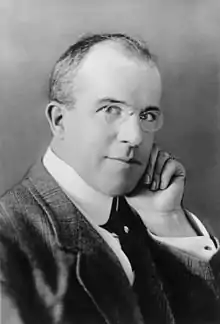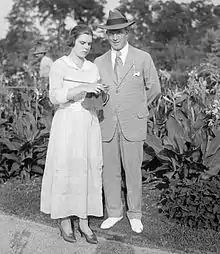J. Stuart Blackton
James Stuart Blackton (January 5, 1875 – August 13, 1941) was a British-American film producer and director of the silent era. One of the pioneers of motion pictures, he founded Vitagraph Studios in 1897. He was one of the first filmmakers to use the techniques of stop-motion and drawn animation, is considered a father of American animation, and was the first to bring many classic plays and books to the screen. Blackton was also the commodore of the Motorboat Club of America[1] and the Atlantic Yacht Club.[2]
James Stuart Blackton | |
|---|---|
 Blackton in 1912 | |
| Born | James Stuart Blacktin January 5, 1875 Sheffield, England |
| Died | August 13, 1941 (aged 66) Los Angeles, California, U.S. |
| Known for | Vitagraph Studios |
| Spouse(s) | Isabelle MacArthur (m. 1897; div. 1906) Paula Hilburn (m. 1908–1930; her death) Rachel Helen Stahl (m. 1931–1933; her death) Evangeline Russell (m. 1936) |
| Children | 4, including Marian Constance Blackton |
| Relatives | Cornell Woolrich (son-in-law) |
Biography
James Stuart Blackton was born on January 5, 1875, in Sheffield, Yorkshire, England, to Henry Blacktin and Jessie Stuart. Henry Blacktin emigrated with his family to the United States in 1885 and changed the family name to Blackton.[2]
He worked as a reporter and illustrator for the New York Evening World, and performed regularly on stage with conjuror Albert Smith.[3] In 1896, Thomas Edison publicly demonstrated the Vitascope, one of the first film projectors, and Blackton was sent to interview Edison and provide drawings of how his films were made. Eager for good publicity, Edison took Blackton to his Black Maria, the special cabin he used to do his filming, and created a film on the spot of Blackton doing a lightning portrait of Edison. The inventor did such a good job selling the art of moviemaking that he talked Blackton and partner Smith into buying a print of the new film, as well as prints of nine other films, plus a Vitascope to show them to paying audiences.

The new act was a great success, despite the various things Blackton and Smith were doing between the Edison films. The next step was to start making films of their own. In this way the American Vitagraph Company was born.[2]
During this period, J. Stuart Blackton ran the Vitagraph studio, and produced, directed, and wrote its films. He even starred in some of his films, playing the comic strip character "Happy Hooligan" in a series of shorts. Since profits were constantly increasing, Blackton felt that he could try any idea that sprang to his head, and in a series of films Blackton developed the concepts of animation.
Animated films
The first of his animation films is The Enchanted Drawing, with a copyright date of 1900 but probably made at least a year earlier.[2] In this film, Blackton sketches a face, a bottle of wine and a glass, a top hat, and a cigar. During the film he appears to remove the wine, glass, hat, and cigar as real objects, and the face appears to react. The "animation" here is of the stop-action variety, where the camera is stopped, a single change is made, and the camera is then started again. The process was first used by Georges Méliès and others.
The transition to stop-motion was apparently accidental, and occurred around 1905. According to Albert Smith, one day the crew was filming a complex series of stop-action effects on the roof while steam from the building's generator was billowing in the background. On playing the film back, Smith noticed the odd effect created by the steam puffs scooting across the screen and decided to reproduce it deliberately. A few films (some of which are lost) use this effect to represent invisible ghosts, or to have toys come to life. In 1906, Blackton directed Humorous Phases of Funny Faces, which uses stop-motion as well as stick puppetry to produce a series of effects. After Blackton's hand draws two faces on a chalkboard, they appear to come to life and engage in antics. Most of the film uses live action effects instead of animation, but nevertheless this film had a huge effect in stimulating the creation of animated films in America. In Europe, the same effect was had from The Haunted Hotel (1907), another Vitagraph short directed by Blackton. The Haunted Hotel was mostly live-action, about a tourist spending the night in an inn run by invisible spirits. Most of the effects are also live-action (wires and such), but one scene of a dinner making itself was done using stop-motion, and was presented in a tight close-up that allowed budding animators to study it for technique.
Blackton made another animated film that has survived, 1907's Lightning Sketches, but it has nothing to add to the art of animation. In 1908 he made the first American film version of Romeo and Juliet, filmed in New York City's Central Park and The Thieving Hand, filmed in Flatbush, Brooklyn. By 1909, Blackton was too absorbed in the business of running Vitagraph to have time for filmmaking. He came to regard his animation experiments in particular as being rather juvenile (they receive no mention in his unpublished autobiography).
Dramatic films and later life

Stuart Blackton believed that the US should join the Allies involved in World War I overseas and in 1915 produced The Battle Cry of Peace. Former President Theodore Roosevelt was one of the film's staunchest supporters and convinced Gen. Leonard Wood to loan Blackton an entire regiment of marines to use as extras. Upon its release, the film generated a controversy rivaling that of The Birth of a Nation because it was considered as militaristic propaganda.
Blackton left Vitagraph to go independent in 1917, but returned in 1923 as junior partner to Albert Smith. In 1925, Smith sold the company to Warner Brothers for more than $1 million.[1]
Blackton did quite well with his share until the Stock Market Crash of 1929, which destroyed his savings and made him bankrupt in 1931.[1] He spent his last years on the road, showing his old films and lecturing about the days of silent movies. His daughter Violet Virginia Blackton (1910–1965) married writer Cornell Woolrich in 1930 but their marriage was annulled in 1933.
He married actress Evangeline Russell in 1936.[5]
Blackton died August 13, 1941, a few days after he suffered a fractured skull[1] after being hit by a motorist while crossing the street with his son.[2][6] At the time of his death he was working for Hal Roach on experiments to improve color process backgrounds.[7] Blackton was cremated and interred at Forest Lawn Memorial Park Cemetery in Glendale, California.[8]
Select filmography
Archives
Blackton's film The Film Parade was restored by the UCLA Film and Television Archive in 2009.[22] The Academy Film Archive preserved Blackton's 1910 film A Modern Cinderella in 2012.[23]
References
- "Commodore Blackton, Who Went from Riches to Relief, Dies at 66". Variety. August 20, 1941. p. 4.
- "Blackton, Pioneer In Movies, Dies, 66. Ex-Commodore of Atlantic Yacht Club Here. Is Victim of Auto Accident. A Founder Of Vitagraph. Producer of 'Black Diamond Express' Thriller. Began as Marine Artist". New York Times. August 14, 1941. Retrieved December 6, 2014.
- Gifford, Denis. "James Stuart Blackton". Who's Who of Victorian Cinema. Retrieved December 9, 2013.
- Howard, Cameron (September 27, 2013). "Marian Constance Blackton". Women Film Pioneers Project. Center for Digital Research and Scholarship, Columbia University Libraries. Retrieved August 4, 2016.
- "Stuart Blackton To Wed. One-Time Partner of Edison to Marry Evangeline Russell". The New York Times. October 3, 1936. Retrieved December 6, 2014.
Commodore J. Stuart Blackton, one-time partner of the late Thomas A. Edison in the production of motion pictures, has made known his engagement to Mrs. Evangeline Russell de Rippeteau, film actress.
- "J. Stuart Blackton's Condition Is Critical". Motion Picture Daily. August 13, 1941. Retrieved September 3, 2014.
- "Blackton Services Tomorrow in L.A." Motion Picture Daily. August 15, 1941. Retrieved September 3, 2014.
- Newsday
- Slide, Anthony (1976). The Big V: A History of the Vitagraph Company. Metuchen, N.J.: Scarecrow Press. ISBN 9780810809673.
- "The Burglar on the Roof". Progressive Silent Film List. Silent Era. Retrieved August 3, 2016.
- "Tearing Down the Spanish Flag". Progressive Silent Film List. Silent Era. Retrieved August 3, 2016.
- "The Adventures of Sherlock Holmes; or, Held for a Ransom". Progressive Silent Film List. Silent Era. Retrieved August 3, 2016.
- Douglas Alver Menville, R. Reginald, Mary Wickizer Burgess Futurevisions: the new golden age of the science fiction film 1985 – Page 14 "Although previous filmmakers had used the near future as a backdrop for their stories (The Airship, or 100 Years Hence, was produced by J. Stuart Blackton in 1908), Lang's vision is the first serious attempt to predict a possible tomorrow."
- "Les Miserables". Progressive Silent Film List. Silent Era. Retrieved August 3, 2016.
- "A Midsummer Night's Dream". Progressive Silent Film List. Silent Era. Retrieved August 3, 2016.
- Vito Attolini "Immagini del Medievo nel cinema", Bari 1993
- "J. Stuart Blackton". BFI Film & TV Database. British Film Institute. Archived from the original on September 15, 2016. Retrieved August 3, 2016.
- "The Battle Cry of Peace". Progressive Silent Film List. Silent Era. Retrieved August 3, 2016.
- "Crooky". American Film Institute. Retrieved September 8, 2021.
- "The Judgement House". Progressive Silent Film List. Silent Era. Retrieved August 3, 2016.
- Workman, Christopher; Howarth, Troy (2016). "Tome of Terror: Horror Films of the Silent Era". Midnight Marquee Press. p. 222.ISBN 978-1936168-68-2.
- "The Film Parade (1933); Vitagraph Treasures". UCLA Film and Television Archive. Retrieved August 4, 2016.
- "Preserved Projects". Academy Film Archive.
Further reading
- Dewey, Donald (2016). Buccaneer: James Stuart Blackton and the Birth of American Movies. Rowman & Littlefield. ISBN 978-1-4422-4259-3.
- Trimble, Marian Blackton (1985). J. Stuart Blackton: a personal biography by his daughter. Scarecrow Press. ISBN 978-0-8108-1765-4.
External links
 Media related to James Stuart Blackton at Wikimedia Commons
Media related to James Stuart Blackton at Wikimedia Commons Works by or about J. Stuart Blackton at Wikisource
Works by or about J. Stuart Blackton at Wikisource- J. Stuart Blackton at the AFI Catalog of Feature Films, American Film Institute
- J. Stuart Blackton at IMDb
.jpg.webp)
_-_1.jpg.webp)